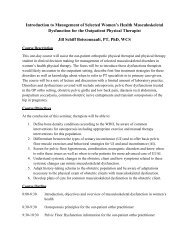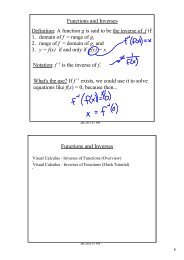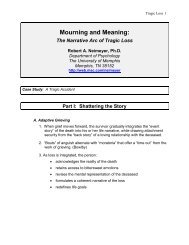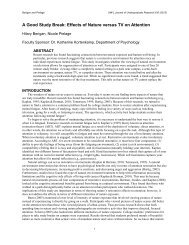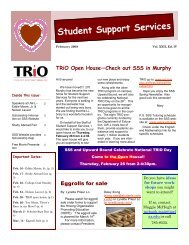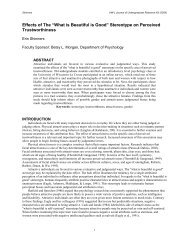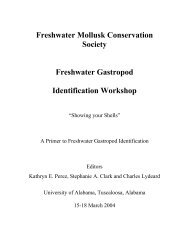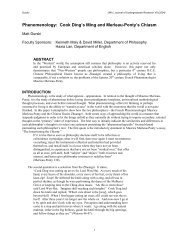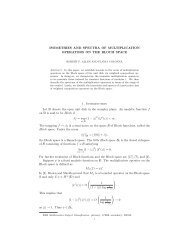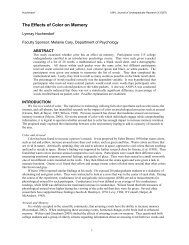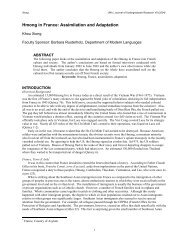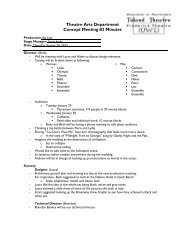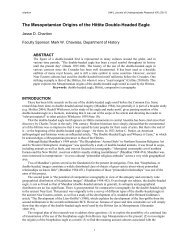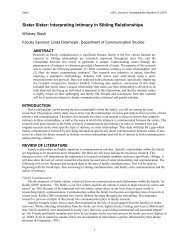A Guide for Terrestrial Gastropod Identification - University of ...
A Guide for Terrestrial Gastropod Identification - University of ...
A Guide for Terrestrial Gastropod Identification - University of ...
You also want an ePaper? Increase the reach of your titles
YUMPU automatically turns print PDFs into web optimized ePapers that Google loves.
Land Snail Collection Strategies<br />
Marla L. Coppolino, Southern Illinois <strong>University</strong> Carbondale<br />
Despite that land snails don’t seem to share the same spotlight in the mollusk world as<br />
marine or even freshwater mollusks do, there are many worthwhile reasons to collect and study<br />
land snails. Land snails are easily accessible, ubiquitous in distribution, and they do not require<br />
expensive or elaborate equipment to collect. They represent an understudied group (Lydeard et<br />
al., 2004), and there is much knowledge to be gained from these organisms and their habitat<br />
associations. Land snails are a vital part <strong>of</strong> the ecosystem and take up essential nutrients from<br />
the detritus and soil, which are then in turn passed on to higher trophic levels, inevitably<br />
affecting them <strong>for</strong> better or <strong>for</strong> worse (Barker, 2004). Land snails are studied <strong>for</strong> their capacity<br />
as ecological indicators (Shimek, 1930), and even as indicators <strong>of</strong> the effects <strong>of</strong> pollution and<br />
global climate change (Graveland et al., 1994; Regoli et al., 2006). Many <strong>of</strong> these types <strong>of</strong><br />
studies are in their early stages. Much remains to be learned about land snails. And so, the<br />
world needs more land snail collectors!<br />
The literature on land snail collecting suggests a wide array <strong>of</strong> methodologies. Basic<br />
questions should be asked be<strong>for</strong>e embarking on research, whether <strong>for</strong>mal or in<strong>for</strong>mal, that<br />
involve the collection <strong>of</strong> land snails:<br />
1) Is the study exploratory in nature, that is, is the intention <strong>of</strong> the collector surveying an<br />
area to “see what’s there”?<br />
2) Are multiple areas being surveyed?<br />
3) Does the investigation also include comparisons <strong>of</strong> land snail populations with habitat<br />
and microhabitat?<br />
4) Is the method intended to be repeatable and quantifiable?<br />
Land snail collecting can be divided into two basic categories: qualitative and<br />
quantitative. Historically speaking, most <strong>of</strong> the collecting in North America has been qualitative.<br />
This means that areas are searched <strong>for</strong> snails without being under the confines <strong>of</strong> measured time<br />
or space. Locality data <strong>for</strong> the specimen is recorded by the collector, <strong>of</strong>ten along with other<br />
in<strong>for</strong>mation relating to its habitat. The data from these ef<strong>for</strong>ts, amassed by important collectors<br />
<strong>of</strong> the past such as Henry Pilsbry, Frank C. Baker, and Leslie Hubricht, have <strong>of</strong>fered<br />
contemporary collectors a very useful baseline <strong>of</strong> in<strong>for</strong>mation on species, and their habitats and<br />
ranges.<br />
Since around the mid-20 th century, collecting ef<strong>for</strong>ts in North America have turned more<br />
towards quantifiable studies. A quantitative study implies that land snails are collected using<br />
some standard measurement, either by time, by volume sampled (leaf litter, soil, etc.) or by area,<br />
and <strong>of</strong>ten by some combination <strong>of</strong> these factors. Most <strong>of</strong>ten, snails collected in this type <strong>of</strong> study<br />
are also accompanied by habitat or microhabitat data, which is also measured in a quantifiable,<br />
repeatable way. When a collecting method is quantitative, the snail and habitat/microhabitat data<br />
can be used in statistical analyses. Most modern studies use quantitative methods <strong>of</strong> collection,<br />
from which population estimates can be obtained (Bishop, 1977).<br />
The basic tools <strong>for</strong> land snail collecting are quite simple. In the field, plastic vials with<br />
attached snap lids are a good choice <strong>for</strong> collecting snails. Most <strong>of</strong>ten, direct visual search is<br />
employed. In many areas, the greatest amount <strong>of</strong> diversity comprises “micro snails”, or<br />
generally speaking, snails that measure less than 5 mm at the largest shell dimension, and cannot<br />
be readily found in a visual search. To collect these snails most efficiently, leaf litter and usually<br />
12



